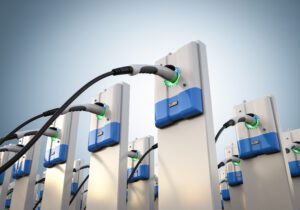Electric mobility is often discussed around the most important hardware – the car. But there is another important hardware besides the electric vehicle – the charger. And when talking about EV charging, there is more than the hardware – it’s software and services.
EV Charging market to grow rapidly until 2030
Analysing the EV charging market for several years and forecasting the market development reveals an attractive, dynamic market for EV charging hardware, software and service providers. The overall market is expected to grow rapidly until 2030 and beyond. Here are some key insights when looking at EV charging markets by region, use case, component, charger and vehicle type.
China has the lead, North America is lagging
Overall market growth is mainly driven by China with its large EV fleet. When comparing North America and Europe, North American EV fleet penetration is expected to lag Europe’s development. The other Asian markets besides China are still small but with some dynamic growth perspectives from a small overall EV fleet. It is expected that the market will mature in most regions after 2030. This will go along with lower growth rates.
Market size and growth differ heavily dependent on the use cases (depot, residential, public etc.). with the increasing EV penetration of personal vehicles, residential charging will probably become the most important use case. But depot charging is expected to be a major use case as well due to the ongoing electrification of last-mile delivery fleets and city / school buses. En-route fast charging will grow slower since network expansion will be limited as soon as more emphasis is put on charger utilization. Workplace and public charging will be interesting niche markets compared to the size of the use cases previously discussed.
Hardware will be the dominant EV charging components but services & software grow faster. But with average prices for chargers expected to decline, EV charging software and services (e.g. fleet management, maintenance) will be the components growing faster than the chargers themselves. Especially charger maintenance services can be an attractive market in the future.
HPC heavily used in en-route charging
Although AC chargers are large in terms of sales volume, DC chargers represent the larger market when it comes to charger types. The average prices for a DC charger is significantly higher than the average price of an AC charger. Within the DC charger segment, high-power chargers (HPC) will grow since they will be frequently used in en-route fast charging. Ultra high power charging (UHPC) above 350 kW will be a niche with low volumes. It is mostly used in en-route fast charging for trucks. For these use cases other technologies such as fuel cell might come into play.
The vehicle per charger ratio will increase with growing EV fleets for most types of vehicles (light, truck, bus etc.). The ratio varies across use cases. For example, en-route fast charging will be mostly used for trips exceeding the battery range. The number of vehicles using these chargers will be higher than for residential or depot charging. Therefore, the vehicles per charger ratio is relatively high.
The EV charging market is complex and moving quickly. Detailing these overall market trends will provide further insights for EV charging players and investors.





